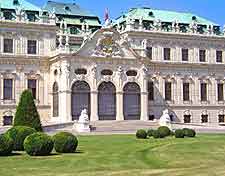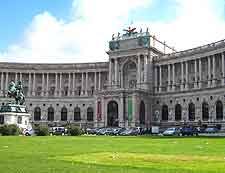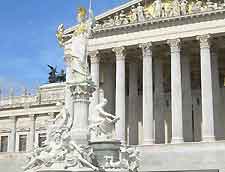Vienna History Facts and Timeline
(Vienna / Wien, Austria)

The city of Vienna has enjoyed a long history, overcoming many conflicts and problems over the centuries, with Duke Henry II of Austria awarding the city its prestigious title of Austrian capital in 1155.
Evidence exists that this part of Austria has seen settlement since at least 500 BC, with Celts being drawn by the River Danube. Just before the dawn of the first century, Romans arrived in Vienna and began to fortify the area, naming it Vindobona. The site was used as a strategic stronghold, protecting the Roman empire from possible Germanic attack. In the 3rd century, the Roman settlement became a 'municipium' (town). Even today, remains of these Roman times can be seen within the Innere Stadt (1st District).
The Migration Period (Volkerwanderung)
By the end of the 4th century, the majority of the Romans had left Vindobona and a more unsettled period in history arrived, along with various immigrants. A small settlement began to establish itself here once more, although fire damage soon after proved to be a major setback.
Medieval Vienna was strongly influenced by its Roman roots and many of the new buildings that were being constructed followed the basic earlier layout of the town, incorporating the old walls and roads. A number of 6th-century coins have been unearthed here, indicating that the settlement was relatively established and trading well at this time in Vienna history.

Rulers of the City
Various different individuals have ruled over Vienna over the centuries, such as the Babenberg family between the 10th and 13th centuries, followed by the House of Habsburg in the 13th century. Keen not to be outdone by the booming city of
Prague, the Habsburg royalty commissioned many ambitious building projects, including the expansion of the already grand St. Stephen's Cathedral (Stephansdom), previously completed in 1160.
The 14th century saw the instigation of cautious economic policies at the hands of Rudolf IV, Duke of Austria, and Vienna enjoyed an era of much affluence. Rudolf was also responsible for the establishment of the University of Vienna (Universitat Wien) in 1365, which is now Austria's biggest and contains a staggering student base approaching 90,000. The Stephansdom was further expanded to incorporate a gothic nave and was finally inaugurated as a cathedral in 1469, gaining its own bishop.
Sieges and Fortifications in the 16th and 17th Centuries
Vienna was victorious when it was attacked by the Ottoman Turks in 1529, thanks in no small part to its substantial medieval walls. Further fortifications were built well into the 17th century, with the city becoming a giant fortress, encircled by a series of bastions and a moat. In 1683, Vienna was once again successful in defending itself during the Second Turkish Siege, which lasted for around two months.
History of the 18th and 19th Centuries
At the very end of the 17th century, Vienna became something of a baroque city, with leading Austrian and Italian architects guiding the expansion plans. Many grand palaces were soon completed, including the Stadtpalais Liechtenstein in 1705 and the Schwarzenberg in 1728, while the already existing Schonbrunn Palace was further embellished. In both 1679 and again in 1713, Vienna suffered great losses when the plague took its toll, although by the 1720s, the population had managed to exceed an impressive 150,000, growing to 200,000 by the end of the 18th century. By now, a sewerage system had been implemented in the city and hygiene was greatly improved.
The Napoleonic Wars resulted in ownership of Vienna passing to
France on no less than two occasions, in 1805 and 1809. Following the defeat of Napoleon, the Congress of Vienna was staged between 1814 and 1815, to discuss the politics of Europe and resolve any outstanding issues.
The Great Flood of 1830 saw the banks of the River Danube burst, flooding the entire district of Augarten to a depth of almost 2 metres / 6.5 feet. After this catastrophe, a number of the Danube's branches were stopped and the river partially redirected, away from the centre of the city.
In the middle of the 19th century, Vienna was ruled over by Emperor Franz Joseph I and enjoyed much expansion. The fortifications were replaced with the Ringstrasse boulevard and the character of today's city was born.

Immigration, Population Explosion and the World Wars
Many immigrants were attracted to Vienna and began to arrive in hordes towards the end of the 19th century. In fact, by the first decade of the 20th century, the capital was home to more than two million residents, meaning that further expansion was necessary.
The First World War saw food in scarce supply, while the Second World War saw Vienna briefly lose its capital status to
Berlin, during German occupation. Following the end of the war, the city was encircled by the Soviet-occupied zone and divided into a series of four individual sectors, which remained in place until the signing of the Austrian State Treaty in 1955. In the 1970s, the Vienna International Centre was constructed for the United Nations.
Tourists in the 21st-Century City
The historical centre of Vienna is now a deserved Unesco World Heritage Site, with many beautiful old buildings clearly displaying elements of its history. Very much celebrated is the city's rich musical heritage, with numerous famous classical composers staying here over the years, such as Ludwig van Beethoven, Johannes Brahms and Wolfgang Amadeus Mozart.
The centrally located Vienna State Opera (Wiener Staatsoper) dates back to the middle of the 19th century and remains central to the city's rich cultural scene.
 The city of Vienna has enjoyed a long history, overcoming many conflicts and problems over the centuries, with Duke Henry II of Austria awarding the city its prestigious title of Austrian capital in 1155.
The city of Vienna has enjoyed a long history, overcoming many conflicts and problems over the centuries, with Duke Henry II of Austria awarding the city its prestigious title of Austrian capital in 1155.
